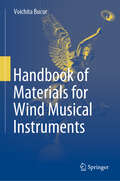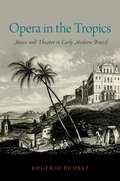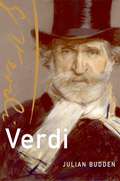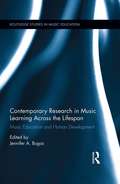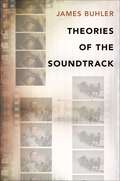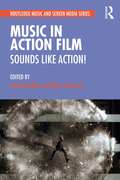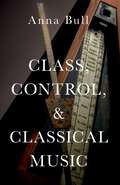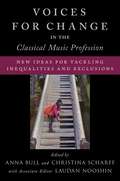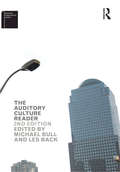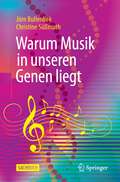- Table View
- List View
Handbook of Materials for Percussion Musical Instruments
by Voichita BucurThis book describes the properties of materials used for making percussion instruments for classical music played by a symphony orchestra in which the instruments could be played as a soloist instrument or as a group or several groups of instruments, as they are included into a musical work. A chapter is devoted to the bells. The scope of this book is primarily confined to percussion instruments of symphony orchestras taking into account the centuries of musical art and tradition. This book bridges the gap in the technical literature on describing the properties of materials for percussion instruments—timpani, other drums, marimba, xylophone, vibraphone, gong, cymbal, triangle, celesta, castanets.
Handbook of Materials for String Musical Instruments
by Voichita BucurThis book addresses core questions about the role of materials in general and of wood in particular in the construction of string instruments used in the modern symphony orchestra – violins, violas, cellos and basses. Further attention is given to materials for classical guitars, harps, harpsichords and pianos. While some of the approaches discussed are traditional, most of them depend upon new scientific approaches to the study of the structure of materials, such as for example wood cell structure, which is visible only using modern high resolution microscopic techniques. Many examples of modern and classical instruments are examined, together with the relevance of classical techniques for the treatment of wood. Composite materials, especially designed for soundboards could be a good substitute for some traditional wood species. The body and soundboard of the instrument are of major importance for their acoustical properties, but the study also examines traditional and new wood species used for items such as bows, the instrument neck, string pegs, etc. Wood species’ properties for musical instruments and growth origins of woods used by great makers such as Antonio Stradivari are examined and compared with more recently grown woods available to current makers. The role of varnish in the appearance and acoustics of the final instrument is also discussed, since it has often been proposed as a ‘secret ingredient’ used by great makers. Aspects related to strings are commented.As well as discussing these subjects, with many illustrations from classical and contemporary instruments, the book gives attention to conservation and restoration of old instruments and the physical results of these techniques. There is also discussion of the current value of old instruments both for modern performances and as works of art having great monetary value.The book will be of interest and value to researchers, advanced students, music historians, and contemporary string instrument makers. Musicians in general, particularly those playing string instruments, will also find its revelations fascinating. It will also attract the attention of those using wood for a variety of other purposes, for its use in musical instruments uncovers many of its fundamental features.Professor Neville H. FletcherAustralian National University, Canberra
Handbook of Materials for Wind Musical Instruments
by Voichita BucurThis book addresses key questions about the materials used for the wind instruments of classical symphony orchestra such as flutes, clarinets, saxophones, oboes, bassoons and pipe organs. The content of this book is structured into four parts.Part 1- Description of materials for wind instruments deals with wood species and materials for reeds used for making clarinet, oboe and bassoon- and, with metallic materials and alloys for - horn, trumpet, trombone, etc. Auxiliary materials associated with the manufacturing of wind instruments are felt, cork, leather and parchment. Part 2- Basic acoustics of wind instruments, in which are presented succinctly, some pertinent aspects related to the physics of the resonant air column. An important aspect discussed is related to the effect of wall material on the vibration modes of the walls of wind instruments. The methods for measuring the acoustical properties of wind instruments are presented. Part 3- Manufacturing of wind instruments, describes the technology used in manufacturing metallic tubes and pipes made of wood. Part 4 - The durability and degradation of materials addresses data about methods for cleaning wind instruments, studies factors producing degradation of organ pipes, describes methods of conservation and restoration of brass instruments and of historical pipe organs. Finally, the properties of marble are described, being the only one nondegradable and sustainable material used for pipes for organs.
Opera in the Tropics: Music and Theater in Early Modern Brazil (Currents in Latin American and Iberian Music)
by Rogério BudaszOpera in the Tropics is an engaging exploration of theater with music in Brazil from the mid 1500s to the early 1820s. Author Rogério Budasz delves into the practices of the actors, singers, poets, and composers who created and performed Jesuit moral plays, Spanish comedias, and Portuguese vernacular operas and entremezes during the colonial period, as well as the Italian operas that celebrated the new independent nation in 1822. A Brazilian producer claimed in 1825 that the goal of music-theater was to instruct, entertain, and distract the population. Budasz argues that this threefold goal had in fact been present throughout the colonial period, in different combinations and with different purposes, at the hands of missionaries, intellectuals, bureaucrats, political leaders, and cultural producers. While Budasz demonstrates a continuity from Portuguese theatrical practices, primarily through the circulation of artists and repertory, he also examines a number of localized departures from the metropolitan model, particularly in the ethnic and gender profile of theatrical workers, in the modifications determined by local tastes, priorities, and materials, and in the political use of theater as an ideological and civilizing tool within the paradoxical context of a slave society. An eye-opening narrative of the transformations and uses of a colonial art form, Opera in the Tropics will be essential reading for all interested in the music and theater in Iberian and Latin American culture.
Opera in the Tropics: Music and Theater in Early Modern Brazil (Currents in Latin American and Iberian Music)
by Rogério BudaszOpera in the Tropics is an engaging exploration of theater with music in Brazil from the mid 1500s to the early 1820s. Author Rogério Budasz delves into the practices of the actors, singers, poets, and composers who created and performed Jesuit moral plays, Spanish comedias, and Portuguese vernacular operas and entremezes during the colonial period, as well as the Italian operas that celebrated the new independent nation in 1822. A Brazilian producer claimed in 1825 that the goal of music-theater was to instruct, entertain, and distract the population. Budasz argues that this threefold goal had in fact been present throughout the colonial period, in different combinations and with different purposes, at the hands of missionaries, intellectuals, bureaucrats, political leaders, and cultural producers. While Budasz demonstrates a continuity from Portuguese theatrical practices, primarily through the circulation of artists and repertory, he also examines a number of localized departures from the metropolitan model, particularly in the ethnic and gender profile of theatrical workers, in the modifications determined by local tastes, priorities, and materials, and in the political use of theater as an ideological and civilizing tool within the paradoxical context of a slave society. An eye-opening narrative of the transformations and uses of a colonial art form, Opera in the Tropics will be essential reading for all interested in the music and theater in Iberian and Latin American culture.
Music and the Emotions: The Philosophical Theories (International Library of Philosophy)
by Malcolm BuddIt has often been claimed, and frequently denied, that music derives some or all of its artistic value from the relation in which it stands to the emotions. This book presents and subjects to critical examination the chief theories about the relationship between the art of music and the emotions.
Music and the Emotions: The Philosophical Theories (International Library of Philosophy)
by Malcolm BuddIt has often been claimed, and frequently denied, that music derives some or all of its artistic value from the relation in which it stands to the emotions. This book presents and subjects to critical examination the chief theories about the relationship between the art of music and the emotions.
Puccini: His Life and Works (Master Musicians Series)
by Julian BuddenJulian Budden, one of the world's foremost scholars of Italian opera and author of a monumental three-volume study of Verdi's works, now offers music lovers a major new biography of one of the giants of Italian opera, Giacomo Puccini. Blending astute musical analysis with a colorful account of Puccini's life, here is an illuminating look at some of the most popular operas in the repertoire, including Manon Lescaut, La Boheme, Tosca, Madama Butterfly, and Turandot. Budden provides an illuminating look at the process of putting an opera together, the cut-and-slash of nineteenth-century Italian opera--the struggle to find the right performers for the debut of La Boheme, Puccini's anxiety about completing Turandot (he in fact died of cancer before he did so), his animosity toward his rival Leoncavallo (whom he called Leonasino or "lion-ass"). Budden provides an informative analysis of the operas themselves, examining the music act by act. He highlights, among other things, the influence of Wagner on Puccini--alone among his Italian contemporaries, Puccini followed Wagner's example in bringing the motif into the forefront of his narrative, sometimes voicing the singer's unexpressed thoughts, sometimes sending out a signal to the audience of which the character is unaware. And Budden also paints an intriguing portrait of Puccini the man--talented but modest, a man who had friends from every walk of life: shopkeepers, priests, wealthy landowners, fellow artists. Affable, well mannered, gifted with a broad sense of fun, he rarely failed to charm all who met him. A new volume in the esteemed Master Musicians series, Puccini offers a masterful portrait of this beloved Italian composer.
Verdi (Master Musicians Series)
by Julian BuddenIn this third edition of the classic Verdi, renowned authority Julian Budden offers a comprehensive overview of Verdi the man and the artist, tracing his ascent from humble beginnings to the status of a cultural patriarch of the new Italy, whose cause he had done much to promote, and demonstrating the gradual enlargement over the years of his artistic vision. This concise study is an accessible, insightful, and engaging summation of Verdi scholarship, acquainting the non-specialist with the personal details Verdi's life, with the operatic world in which he worked, and with his political ideas, his intellectual vision, and his powerful means of communicating them through his music. In his survey of the music itself, Budden emphasizes the unique character of each work as well as the developing sophistication of Verdi's style. He covers all of the operas, the late religious works, the songs, and the string quartet. A glossary explains even the most obscure operatic terms current in Verdi's time.
Verdi (Master Musicians Series)
by Julian BuddenIn this third edition of the classic Verdi, renowned authority Julian Budden offers a comprehensive overview of Verdi the man and the artist, tracing his ascent from humble beginnings to the status of a cultural patriarch of the new Italy, whose cause he had done much to promote, and demonstrating the gradual enlargement over the years of his artistic vision. This concise study is an accessible, insightful, and engaging summation of Verdi scholarship, acquainting the non-specialist with the personal details Verdi's life, with the operatic world in which he worked, and with his political ideas, his intellectual vision, and his powerful means of communicating them through his music. In his survey of the music itself, Budden emphasizes the unique character of each work as well as the developing sophistication of Verdi's style. He covers all of the operas, the late religious works, the songs, and the string quartet. A glossary explains even the most obscure operatic terms current in Verdi's time.
Contemporary Research in Music Learning Across the Lifespan: Music Education and Human Development (Routledge Studies in Music Education)
by Jennifer BugosThis book examines contemporary issues in music teaching and learning throughout the lifespan, illuminating an emerging nexus of trends shaping modern research in music education. In the past, most music learning opportunities and research were focused upon the pre-adult population. Yet, music education occurs throughout the lifespan, from birth until death, emerging not only through traditional formal ensembles and courses, but increasingly through informal settings as well. This book challenges previous assumptions in music education and offers theoretical perspectives that can guide contemporary research and practice. Exploring music teaching and learning practices through the lens of human development, sections highlight recent research on topics that shape music learning trajectories. Themes uniting the book include human development, assessment strategies, technological applications, professional practices, and cultural understanding. The volume deconstructs and reformulates performance ensembles to foster mutually rewarding collaborations across miles and generations. It develops new measures and strategies for assessment practices for professionals as well as frameworks for guiding students to employ effective strategies for self-assessment. Supplemental critical thinking questions focus the reader on research applications and provide insight into future research topics. This volume joining established experts and emerging scholars at the forefront of this multifaceted frontier is essential reading for educators, researchers, and scholars, who will make the promises of the 21st century a reality in music education. It will be of interest to a range of fields including music therapy, lifelong learning, adult learning, human development, community music, psychology of music, and research design.
Contemporary Research in Music Learning Across the Lifespan: Music Education and Human Development (Routledge Studies in Music Education)
by Jennifer A. BugosThis book examines contemporary issues in music teaching and learning throughout the lifespan, illuminating an emerging nexus of trends shaping modern research in music education. In the past, most music learning opportunities and research were focused upon the pre-adult population. Yet, music education occurs throughout the lifespan, from birth until death, emerging not only through traditional formal ensembles and courses, but increasingly through informal settings as well. This book challenges previous assumptions in music education and offers theoretical perspectives that can guide contemporary research and practice. Exploring music teaching and learning practices through the lens of human development, sections highlight recent research on topics that shape music learning trajectories. Themes uniting the book include human development, assessment strategies, technological applications, professional practices, and cultural understanding. The volume deconstructs and reformulates performance ensembles to foster mutually rewarding collaborations across miles and generations. It develops new measures and strategies for assessment practices for professionals as well as frameworks for guiding students to employ effective strategies for self-assessment. Supplemental critical thinking questions focus the reader on research applications and provide insight into future research topics. This volume joining established experts and emerging scholars at the forefront of this multifaceted frontier is essential reading for educators, researchers, and scholars, who will make the promises of the 21st century a reality in music education. It will be of interest to a range of fields including music therapy, lifelong learning, adult learning, human development, community music, psychology of music, and research design.
Theories of the Soundtrack (Oxford Music/Media Series)
by James BuhlerA theory of the soundtrack is concerned with what belongs to the soundtrack, how a soundtrack is effectively organized, how its status in a multimedia object affects the nature of the object, the tools available for its analysis, and the interpretive regime that the theory mandates for determining the meaning, sense, and structure that sound and music bring to film and other audiovisual media. Beyond that, a theory may also delineate the range of possible uses of sound and music, classify the types of relations that films have used for image and sound, identify the central problems, and reflect on and describe effective uses of sound in film. This book summarizes and critiques major theories of the soundtrack from roughly 1929 until today. Rather than providing an exhaustive historical survey, it sketches out the range of theoretical approaches that have been applied to the soundtrack since the commercial introduction of the sound film. The basic theoretical framework of each approach is presented, taking into account the explicit and implicit claims about the soundtrack and its relation to other theories. The organization is both chronological and topical, the former in that the chapters move steadily from early film theory through models of the classical system to more recent critical theories; the latter in that the chapters highlight central issues for each generation: the problem of film itself, then of image and sound, of adequate analytical-descriptive models, and finally of critical-interpretative models.
Theories of the Soundtrack (Oxford Music/Media Series)
by James BuhlerA theory of the soundtrack is concerned with what belongs to the soundtrack, how a soundtrack is effectively organized, how its status in a multimedia object affects the nature of the object, the tools available for its analysis, and the interpretive regime that the theory mandates for determining the meaning, sense, and structure that sound and music bring to film and other audiovisual media. Beyond that, a theory may also delineate the range of possible uses of sound and music, classify the types of relations that films have used for image and sound, identify the central problems, and reflect on and describe effective uses of sound in film. This book summarizes and critiques major theories of the soundtrack from roughly 1929 until today. Rather than providing an exhaustive historical survey, it sketches out the range of theoretical approaches that have been applied to the soundtrack since the commercial introduction of the sound film. The basic theoretical framework of each approach is presented, taking into account the explicit and implicit claims about the soundtrack and its relation to other theories. The organization is both chronological and topical, the former in that the chapters move steadily from early film theory through models of the classical system to more recent critical theories; the latter in that the chapters highlight central issues for each generation: the problem of film itself, then of image and sound, of adequate analytical-descriptive models, and finally of critical-interpretative models.
Music in Action Film: Sounds Like Action!
by James Buhler Mark DurrandMusic in Action Film is the first volume to address the central role of music and sound in action film—arguably the most dominant form of commercial cinema today. Bringing together 15 essays by established and emerging scholars, the book encompasses both Hollywood blockbusters and international films, from classic works such as The Seven Samurai to contemporary superhero franchises. The contributors consider action both as genre and as a mode of cinematic expression, in chapters on evolving musical conventions; politics, representation, and identity; musical affect and agency; the functional role of music and sound design in action film; and production technologies. Breaking new critical ground yet highly accessible, this book will be of interest to students and scholars of music and film studies.
Music in Action Film: Sounds Like Action!
by James Buhler Mark DurrandMusic in Action Film is the first volume to address the central role of music and sound in action film—arguably the most dominant form of commercial cinema today. Bringing together 15 essays by established and emerging scholars, the book encompasses both Hollywood blockbusters and international films, from classic works such as The Seven Samurai to contemporary superhero franchises. The contributors consider action both as genre and as a mode of cinematic expression, in chapters on evolving musical conventions; politics, representation, and identity; musical affect and agency; the functional role of music and sound design in action film; and production technologies. Breaking new critical ground yet highly accessible, this book will be of interest to students and scholars of music and film studies.
Class, Control, and Classical Music
by Anna BullWhy is classical music predominantly the preserve of the white middle classes? Contemporary associations between classical music and social class remain underexplored, with classical music primarily studied as a text rather than as a practice until recent years. In order to answer this question, this book outlines a new approach for a socio-cultural analysis of classical music, asking how musical institutions, practices, and aesthetics are shaped by wider conditions of economic inequality, and how music might enable and entrench such inequalities or work against them. This approach is put into practice through a richly detailed ethnography which locates classical music within one of the cultures that produces it - middle-class English youth - and foregrounds classical music as bodily practice of control and restraint. Drawing on the author's own background as a classical musician, this closely observed account examines youth orchestra and youth choir rehearsals as a space where young people learn the unspoken rules of this culture of weighty tradition and gendered control. It highlights how the middle-classes' habitual roles - boundary drawing around their protected spaces and reproducing their privilege through education - can be traced within the everyday spaces of classical music. These practices are camouflaged, however, by the ideology of 'autonomous art' that classical music carries. Rather than solely examining the social relations around the music, the book demonstrates how this reproductive work is facilitated by its very aesthetic, of 'controlled excitement', 'getting it right', precision, and detail. This book is of particular interest at the present moment, thanks to the worldwide proliferation of El Sistema-inspired programmes which teach classical music to children in underserved areas. While such schemes demonstrate a resurgence in defending the value of classical music, there has been a lack of debate over the ways in which its socio-cultural heritage shapes its conventions today. This book locates these contestations within contemporary debates on class, gender and whiteness, making visible what is at stake in such programmes.
CLASS, CONTROL, AND CLASSICAL MUSIC C
by Anna BullWhy is classical music predominantly the preserve of the white middle classes? Contemporary associations between classical music and social class remain underexplored, with classical music primarily studied as a text rather than as a practice until recent years. In order to answer this question, this book outlines a new approach for a socio-cultural analysis of classical music, asking how musical institutions, practices, and aesthetics are shaped by wider conditions of economic inequality, and how music might enable and entrench such inequalities or work against them. This approach is put into practice through a richly detailed ethnography which locates classical music within one of the cultures that produces it - middle-class English youth - and foregrounds classical music as bodily practice of control and restraint. Drawing on the author's own background as a classical musician, this closely observed account examines youth orchestra and youth choir rehearsals as a space where young people learn the unspoken rules of this culture of weighty tradition and gendered control. It highlights how the middle-classes' habitual roles - boundary drawing around their protected spaces and reproducing their privilege through education - can be traced within the everyday spaces of classical music. These practices are camouflaged, however, by the ideology of 'autonomous art' that classical music carries. Rather than solely examining the social relations around the music, the book demonstrates how this reproductive work is facilitated by its very aesthetic, of 'controlled excitement', 'getting it right', precision, and detail. This book is of particular interest at the present moment, thanks to the worldwide proliferation of El Sistema-inspired programmes which teach classical music to children in underserved areas. While such schemes demonstrate a resurgence in defending the value of classical music, there has been a lack of debate over the ways in which its socio-cultural heritage shapes its conventions today. This book locates these contestations within contemporary debates on class, gender and whiteness, making visible what is at stake in such programmes.
Voices for Change in the Classical Music Profession: New Ideas for Tackling Inequalities and Exclusions
by Anna Bull Christina Scharff Laudan NooshinHow is the classical music industry responding to the challenges of #MeToo, Black Lives Matter, and other social justice movements? Is increasing attention to equity and diversity in the classical music profession over recent years leading to systemic change? In this book, scholars, activists and musicians from countries across Europe and North America analyze inequalities in the classical music profession and introduce strategies for making change. Exploring racism, class and gender inequalities, disability representation, "authenticity", changing the canon, and neoliberalism, the book brings together analyses from academics alongside contributions from musicians and industry leaders working in the classical music industry who reflect on issues of diversity and share insights and best practices. Themes of the book include institutional legacies and possibilities for change; racial, classed and gendered inequalities and marginalised voices; and strategies for activism, whether reflective practices, informal networks, or larger organisations leading change. The book also discusses questions such as whether musical change is necessary for social change in classical music, and how activists can acknowledge structural inequalities whilst holding on to the possibility of change. Opening up the interdisciplinary field of "classical music studies," this book lays the groundwork for empirically-founded, theoretically-informed, and practice-based approaches to tackling inequalities in the classical music profession. As such, it will be a significant point of reference for musicians, students, classical music administrators, policy-makers, teachers, and academics -- and anyone else who wants to make classical music more inclusive.
Voices for Change in the Classical Music Profession: New Ideas for Tackling Inequalities and Exclusions
by Anna Bull Christina Scharff Laudan NooshinHow is the classical music industry responding to the challenges of #MeToo, Black Lives Matter, and other social justice movements? Is increasing attention to equity and diversity in the classical music profession over recent years leading to systemic change? In this book, scholars, activists and musicians from countries across Europe and North America analyze inequalities in the classical music profession and introduce strategies for making change. Exploring racism, class and gender inequalities, disability representation, "authenticity", changing the canon, and neoliberalism, the book brings together analyses from academics alongside contributions from musicians and industry leaders working in the classical music industry who reflect on issues of diversity and share insights and best practices. Themes of the book include institutional legacies and possibilities for change; racial, classed and gendered inequalities and marginalised voices; and strategies for activism, whether reflective practices, informal networks, or larger organisations leading change. The book also discusses questions such as whether musical change is necessary for social change in classical music, and how activists can acknowledge structural inequalities whilst holding on to the possibility of change. Opening up the interdisciplinary field of "classical music studies," this book lays the groundwork for empirically-founded, theoretically-informed, and practice-based approaches to tackling inequalities in the classical music profession. As such, it will be a significant point of reference for musicians, students, classical music administrators, policy-makers, teachers, and academics -- and anyone else who wants to make classical music more inclusive.
The Auditory Culture Reader (Sensory Formations)
by Michael BullThe first edition of The Auditory Culture Reader offered an introduction to both classical and recent work on auditory culture, laying the foundations for new academic research in sound studies. Today, interest and research on sound thrives across disciplines such as music, anthropology, geography, sociology and cultural studies as well as within the new interdisciplinary sphere of sound studies itself. This second edition reflects on the changes to the field since the first edition and offers a vast amount of new content, a user-friendly organization which highlights key themes and concepts, and a methodologies section which addresses practical questions for students setting out on auditory explorations. All essays are accessible to non-experts and encompass scholarship from leading figures in the field, discussing issues relating to sound and listening from the broadest set of interdisciplinary perspectives. Inspiring students and researchers attentive to sound in their work, newly-commissioned and classical excerpts bring urban research and ethnography alive with sensory case studies that open up a world beyond the visual. This book is core reading for all courses that cover the role of sound in culture, within sound studies, anthropology, sociology, cultural studies, history, media studies and urban geography.
Sirens (The Study of Sound)
by Michael BullSirens are sounds that confront us in daily life, from the sounds of police cars and fire engines to, less often, tornado warnings. Ideologies of sirens embody the protective, the seductive and the dangerous elements of siren sounds – from the US Cold War public training exercises in the 1950s and 1960s to the seductive power of the sirens entrenched in popular culture: from Wagner to Dizzee Rascal, from Kafka to Kurt Vonnegut, from Hans Christian Andersen to Walt Disney. This book argues, using a wide array of theorists from Adorno to Bloch and Kittler, that we should understand 'siren sounds' in terms of their myth and materiality, and that sirens represent a sonic confluence of power, gender and destructiveness embedded in core Western ideologies to the present day. Bull poses the question of whether we can rely on sirens, both in their mythic meanings and in their material meanings in contemporary culture.
Sirens (The Study of Sound)
by Michael BullSirens are sounds that confront us in daily life, from the sounds of police cars and fire engines to, less often, tornado warnings. Ideologies of sirens embody the protective, the seductive and the dangerous elements of siren sounds – from the US Cold War public training exercises in the 1950s and 1960s to the seductive power of the sirens entrenched in popular culture: from Wagner to Dizzee Rascal, from Kafka to Kurt Vonnegut, from Hans Christian Andersen to Walt Disney. This book argues, using a wide array of theorists from Adorno to Bloch and Kittler, that we should understand 'siren sounds' in terms of their myth and materiality, and that sirens represent a sonic confluence of power, gender and destructiveness embedded in core Western ideologies to the present day. Bull poses the question of whether we can rely on sirens, both in their mythic meanings and in their material meanings in contemporary culture.
The Auditory Culture Reader (Sensory Formations)
by Michael Bull Les BackThe first edition of The Auditory Culture Reader offered an introduction to both classical and recent work on auditory culture, laying the foundations for new academic research in sound studies. Today, interest and research on sound thrives across disciplines such as music, anthropology, geography, sociology and cultural studies as well as within the new interdisciplinary sphere of sound studies itself. This second edition reflects on the changes to the field since the first edition and offers a vast amount of new content, a user-friendly organization which highlights key themes and concepts, and a methodologies section which addresses practical questions for students setting out on auditory explorations. All essays are accessible to non-experts and encompass scholarship from leading figures in the field, discussing issues relating to sound and listening from the broadest set of interdisciplinary perspectives. Inspiring students and researchers attentive to sound in their work, newly-commissioned and classical excerpts bring urban research and ethnography alive with sensory case studies that open up a world beyond the visual. This book is core reading for all courses that cover the role of sound in culture, within sound studies, anthropology, sociology, cultural studies, history, media studies and urban geography.
Warum Musik in unseren Genen liegt
by Jörn Bullerdiek Christine SüßmuthWussten Sie, warum Johann Sebastian Bach ganz legal lange Finger machte? Und was Sie alles mit einer Haarlocke Mozarts anfangen könnten, wenn Sie sie besäßen? Beides könnte Sie auf die Spur eines uralten Geheimnisses bringen, nämlich warum Menschen Freude am „Hervorbringen musikalischer Töne“ haben, wie Darwin es formulierte. Liegt das wortwörtlich in unserer DNA und was hat es dort zu suchen? Die Autoren sind in gefährlicher Nähe am Felsen der Sirenen vorbei gesegelt und haben Orpheus in die Unterwelt begleitet. Sie haben den Weg von Schallwellen von ihrer Quelle bis zum Gehirn der Hörenden verfolgt und ebenso den Stammbaum der Familie Bach wie den Gesang von Zebrafinken analysiert. Schließlich sind sie nicht nur in den Sonderzug nach Pankow gestiegen, sondern haben auch noch die Caprifischer in ihrer Heimat aufgesucht. Alles in allem ist eine unterhaltsame und informative Analyse dessen entstanden, was vom alten Ägypten bis in heutige Zeit die Faszination von Musik im Spiegel unserer Gene ausmacht.


